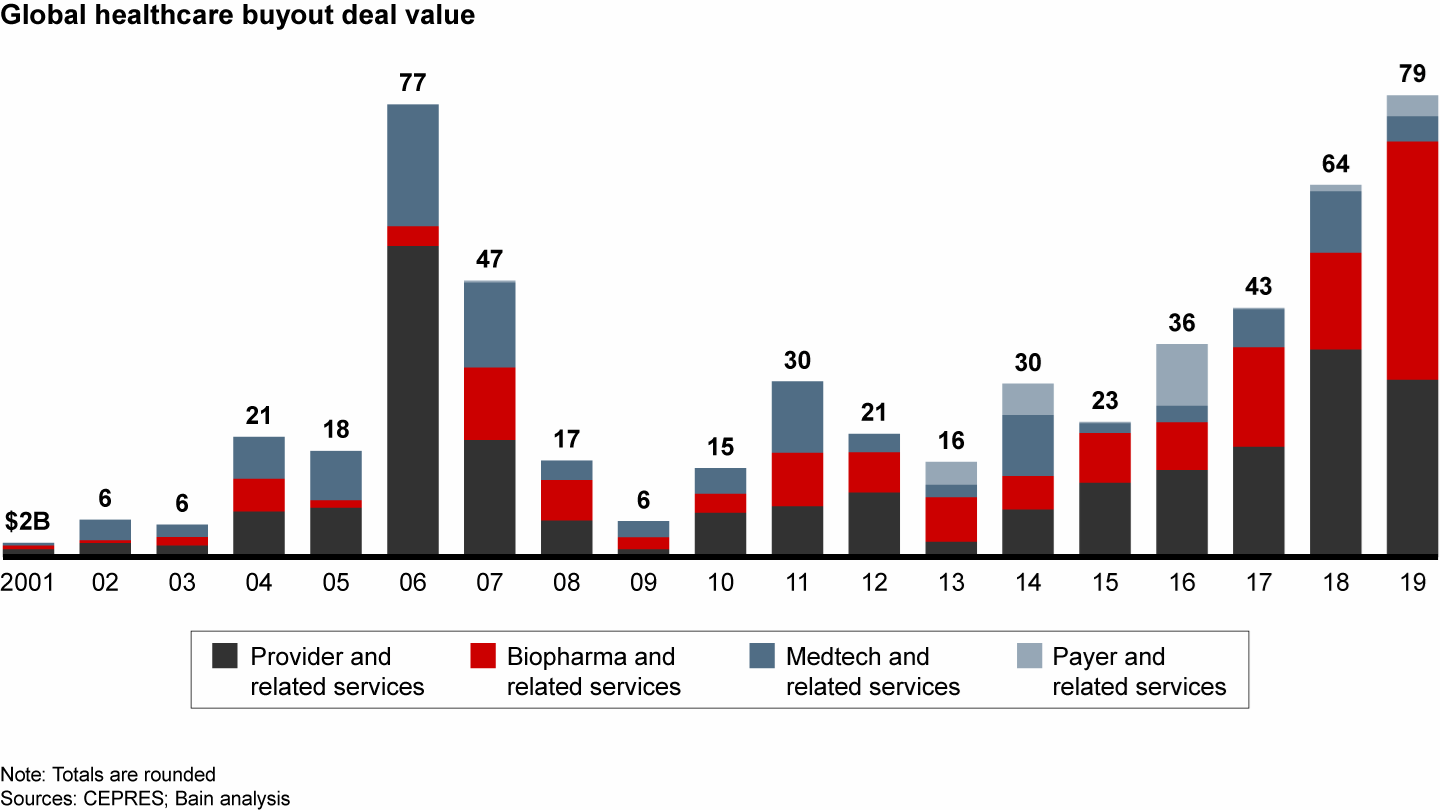Report

Executive Summary
- While the payer and related services sector continued to attract PE investment, there was a limited pool of assets available for sale.
- Disclosed deal value posted its highest level since 2016 at $3.6 billion, driven largely by the Zelis Healthcare and RedCard Systems investments. Disclosed values vary from year to year because only a few large assets traded. Deal count came in at 10 in 2019, in line with the 11 in 2018.
- Four themes accounted for most deals: financing flows and payments; businesses that support Medicare Advantage; businesses that make employer self-funded plans more cost effective; and businesses that realign the value chain.
This article is part of Bain’s 2020 Global Healthcare Private Equity and Corporate M&A Report. Explore the contents of the report here or download the PDF to read the full report.
Disclosed deal value reached the highest level ever in 2019


Payer and related services reached $3.6 billion of disclosed deal value in 2019, the highest level since 2016 as deal activity remained flat. The scarcity of payer assets has led to high multiples, particularly for gem and scale assets that are able to create network effects. In addition, there is strong competition from corporate acquirers that can pay a premium thanks to synergies with existing businesses. For example, UnitedHealth’s Optum unit purchased Equian, a provider of payment integrity.
A couple of structural factors make payer and related services an attractive space for private equity investors. Aging populations along with a rising incidence of chronic disease drive growth in Medicare Advantage and raise spending on healthcare. And advances in data analytics create new opportunities for innovation.
We saw four major investment themes across the sector:
- financing flows and payments;
- support for Medicare Advantage;
- cost reduction for employers’ self-funded plans; and
- value chain realignment and build-out of services businesses.
1. Untangling complexity in financing flows and payments
Payments is a virtual glue binding together payers, providers, members and employers. However, patient out-of-pocket expenses are rising, and various aspects of the payment ecosystem and network benefits suffer from complexity.
Moreover, in many cases, providers have little incentive to go through the trouble of setting up an automated clearinghouse for a new or infrequently used payer. Other methods of payment delivery, such as virtual cards or payment checks, may add more cost or complexity to some providers.
Payers thus want to streamline their relationships as well as create ancillary revenue streams where possible.
Various technologies have improved to the point where they have begun to help tame the complexity, drawing the interest of investors. Among the prominent deals in this space, Bain Capital acquired stakes in Zelis Healthcare and RedCard Systems, which offer tools to help payers manage out-of-network expenses, claims communication and payment solutions.
2. Supporting Medicare Advantage
Medicare Advantage has grown to serve about one-third of all Medicare beneficiaries in the US. Investors have identified opportunities in businesses that support Medicare Advantage across the value chain, including member recruitment and enrollment, network development and management, care and utilization management, and risk assessment and analytics management.
Consider TPG Capital’s purchase of Convey Health Solutions. Convey offers administrative software solutions for government-sponsored health plans and administration of supplemental benefits for Medicare Advantage plans. Convey’s business benefits from the growth of Medicare Advantage.
3. Reducing costs for employers’ self-funded benefit plans
Costs for employer-sponsored healthcare coverage continue to rise, leading more small and midsize employers to choose self-funded plans as a way to manage their costs. Companies are offering solutions aiming to make self-funded plans more cost-effective and feasible for smaller employers.
One deal addressing these needs was Great Hill Partners’ recapitalization of Pareto Health, an employee benefit group captive manager that helps self-funded employers pool risk to create portfolio smoothing and reduce stop-loss costs.
4. Realigning the value chain and building out service businesses
In 2019, health plans continued to vertically integrate and build out services businesses in order to seek differentiation and new levers for growth. Key examples include Anthem’s acquisition of Beacon Health Options, a behavioral health management company, and Humana’s announced acquisition of Enclara Healthcare, a hospice pharmacy and benefits manager.
Realignment of the payer value chain can create opportunities for investors. While corporates sometimes stand as direct competitors to PE bidders here, they also offer a clear exit path and can serve as coinvestors.
The current environment is likely to persist—with some chance of disruption
Interest for payer-related assets should remain high, but the scarcity of assets and intense competition from corporates will probably continue to restrain deal activity.
We expect continued investment in assets on both the revenue side, especially Medicare Advantage and payments, and cost-side services assets. Fee-for-value payment models will continue to gain traction, albeit at different speeds in different parts of the US. This could open new investing opportunities. While the US election in November remains a wild card, given the complexity of enacting a major overhaul it is possible that the landscape remains much the same in the near term.
This article is part of Bain’s 2020 Global Healthcare Private Equity and Corporate M&A Report. Explore the contents of the report here or download the PDF to read the full report.